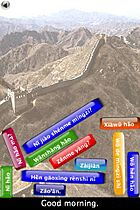Educational software facts for kids
Educational software is any computer program made for learning. It includes many different types, from apps that teach you new languages to tools that help teachers manage their classrooms. The main goal of all educational software is to make learning better and easier for everyone.
Contents
History of Learning Software
Early Days: 1940s to 1970s
Computers started helping with education way back in the 1940s. One of the first uses was for flight simulators. These simulators used special computers to train pilots. An example was the type19 radar trainer from 1943.
In these early years, educational software was often built right into the computer it ran on. Famous early systems included the PLATO system (started in 1960) and TICCIT (from 1969).
In 1963, IBM worked with Stanford University to create a big computer-assisted learning program. This program was used in schools in California and Mississippi. By 1967, a company called Computer Curriculum Corporation (CCC) was formed to sell these learning tools to schools. Back then, the computers needed for this software cost over $10,000, which was a lot of money!
Some early programming languages, like LOGO (1967), were made just for students. The PLATO IV system (1972) added cool features. These included bitmap graphics (like early pictures), basic sounds, and even touchscreens. Many of these features are common in today's software.
Personal Computers Arrive: 1970s to 1980s
Everything changed when personal computers came out in 1975, starting with the Altair 8800. Before this, people had to use huge, expensive computers owned by universities. But after 1975, people could buy computers for their homes and schools for less than $2000.
By the early 1980s, computers like the Apple II (1977), Commodore PET (1977), and Commodore 64 (1982) became popular. This led to many companies making educational software. Companies like Broderbund and The Learning Company became well-known. MECC was a key non-profit group. They created many learning programs, especially for the Apple II computer.
Types of Educational Software
Courseware
"Courseware" is a mix of "course" and "software." It first meant extra learning materials for teachers or students. These materials usually came with a computer program. Now, "courseware" can mean a whole online course. It includes all the lessons, tests, and other materials. Many companies use this term for a complete learning "package." Courseware can be online, like web pages, or files you can download.
Classroom Helper Software
Some educational software is made for use in school classrooms. Teachers might show this software on a big screen or interactive whiteboard. Students can also use it on computers in a classroom network. SMART Notebook is a famous example used with SMART Boards. It lets teachers draw and write digitally on the board. This type of software is often called classroom management software. It helps teachers teach better. For example, 'Wordshark' helps students learn to read and spell with fun games.
Testing and Assessment Software
Many schools want to use less paper. So, they are using assessment software more often. This software helps test students in a digital way. It means fewer paper tests.
Recently, new tools using Large Language Models (like advanced AI) have appeared. These tools help teachers by giving feedback and grading suggestions for student writing. However, some studies have found problems with these AI grading tools. They can sometimes give different grades for the same work. They might also struggle to spot silly answers. This means teachers should be careful not to rely too much on AI for grading.
Learning for Specific Topics
There are many special types of educational software. These programs focus on very specific learning needs. For example, there's software to help you learn a new language. There are also programs for designing and printing paper models.
Video Games and Learning
Video games can be great for teaching new skills. They can help you learn about technology or other subjects. For example, Microsoft Solitaire was made to help people learn how to use a mouse and drag-and-drop items on a screen. Mavis Beacon Teaches Typing uses mini-games to make learning to type fun.
Gamification means using game ideas in non-game situations. It can make learning more exciting and help people change their habits. Adding game elements can make tasks feel more motivating.
How Educational Software Helps
Software as a Tutor
Tutor-based educational software acts like a personal teacher. It tries to copy the one-on-one help a tutor gives. Research shows this type of software can really help students. It can make them understand topics better and faster.
Helping Students with Disabilities
A study looked at how educational software helps children with mild disabilities. The results were positive. The software helped these children learn social skills. It did this through team-based activities, discussions, videos, and games.
Checking Educational Software Quality
There is a lot of educational software available today. A team created a system to check how good this software is. It's called the Construction of the Comprehensive Evaluation of Electronic Learning Tools and Educational Software (CEELTES). This system grades software on different points. It looks at how well the software works, its content, how easy it is to use, and how it helps with learning.
Learning in Universities
In university computer science classes, learning about logic is very important. There are educational tools like FOLST and LogicChess. These tools help university students understand complex logic concepts. They make it easier to learn about designing logical systems.
See also
 In Spanish: Software educativo para niños
In Spanish: Software educativo para niños
- Adaptive learning
- Computer-assisted language learning
- Educational game
- Educational technology
- Educational entertainment Edutainment
- List of educational software
- List of free and open-source educational software
- Instructional technology
- Typing software – Keyboard trainer program


